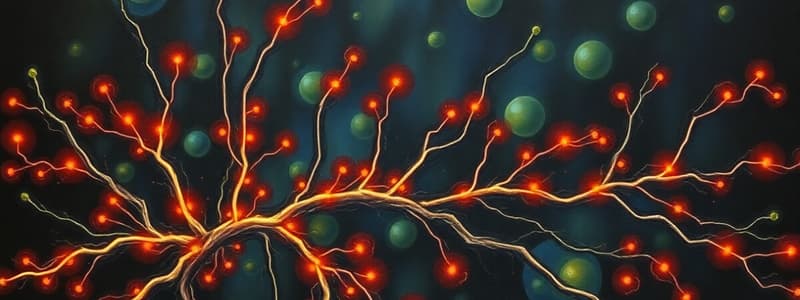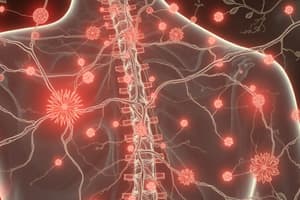Podcast
Questions and Answers
What neurotransmitter is involved in blocking pain signals at the 'pain gate' from the midbrain?
What neurotransmitter is involved in blocking pain signals at the 'pain gate' from the midbrain?
- Histamine
- Acetylcholine
- Serotonin (correct)
- Dopamine
Which opioid is a pure agonist primarily targeting mu receptors?
Which opioid is a pure agonist primarily targeting mu receptors?
- Kratom
- Naloxone
- Morphine (correct)
- Pentazocine
What is the role of opiates such as morphine and codeine?
What is the role of opiates such as morphine and codeine?
- Decrease inflammation and reduce blood pressure
- Block pain transmission and provide analgesia (correct)
- Act as an antihistamine and reduce allergy symptoms
- Induce sleep and enhance memory
Which of the following is NOT a type of endogenous opioid ligand?
Which of the following is NOT a type of endogenous opioid ligand?
Which drug is primarily associated with influencing cognitive and emotional processing related to pain?
Which drug is primarily associated with influencing cognitive and emotional processing related to pain?
Which drug is specifically used to reverse overdoses?
Which drug is specifically used to reverse overdoses?
What is the primary advantage of partial agonists like Buprenorphine?
What is the primary advantage of partial agonists like Buprenorphine?
Which combined formulation is used to increase effectiveness against opioid misuse?
Which combined formulation is used to increase effectiveness against opioid misuse?
What characteristic limits the usefulness of Pentazocine as an analgesic?
What characteristic limits the usefulness of Pentazocine as an analgesic?
Which drug class does Fentanyl belong to based on its potency compared to morphine?
Which drug class does Fentanyl belong to based on its potency compared to morphine?
Flashcards
Morphine/codeine
Morphine/codeine
Opioid pain relievers; morphine is stronger
Fentanyl
Fentanyl
Powerful opioid; much stronger than morphine
Naloxone (Narcan)
Naloxone (Narcan)
Opioid overdose reversal agent
Partial Mu Agonist
Partial Mu Agonist
Signup and view all the flashcards
Suboxone
Suboxone
Signup and view all the flashcards
Opioids
Opioids
Signup and view all the flashcards
Pain Pathway
Pain Pathway
Signup and view all the flashcards
Opioid Receptors
Opioid Receptors
Signup and view all the flashcards
Descending Anti-pain Pathways
Descending Anti-pain Pathways
Signup and view all the flashcards
Opiate vs. Opioid
Opiate vs. Opioid
Signup and view all the flashcards
Study Notes
Pain Pathways and Opiates
- Pain signals travel from free nerve endings to the spinal cord, then to the thalamus, and finally to the somatosensory cortex.
- Emotional and cognitive aspects of pain involve the hippocampus, amygdala, and cingulate cortex.
- Anti-pain pathways originate in the midbrain, using serotonin and norepinephrine to block pain signals.
- Opiates enhance the effects of these anti-pain pathways.
Opportunities to Decrease Pain
- Reducing inflammation (e.g., with aspirin, NSAIDs).
- Decreasing nociceptor excitation (e.g., gabapentin, pregabalin).
- Decreasing neurotransmitter release from nociceptors (e.g., opioids).
- Activating anti-pain pathways (e.g., antidepressants, opioids).
- Influencing cognitive and emotional responses to pain (e.g., opioids).
Terminology
- Opium: Juice extracted from the poppy plant.
- Narcotic: Any sleep-inducing drug, encompassing opiates.
- Opiate: A drug derived from opium (e.g., morphine, codeine).
- Opioid: An endogenous ligand that binds to opioid receptors (e.g., endorphins, enkephalins, dynorphins). "Opioid" now includes synthetic drugs acting on these receptors.
Opium Source and History
- Opium comes from the Papaver somniferum plant.
- Native to Eurasia.
- Used for thousands of years.
- Mixed with alcohol to create laudanum.
- Hypodermic injection in the 1800s contributed to the problem of addiction.
Opioid Functions and Synthesis
- Analgesia (pain relief)
- Sleep induction
- Cough suppression (anti-tussive)
- Regulating intestinal muscles.
- Produced from precursor polypeptides, cleaved into active forms by proteases.
- Endorphins from POMC
- Enkephalins from proenkephalin
- Endorphins and dynorphins from proendorphin
Opioid Receptors
- Metabotropic receptors (MU, KAPPA, DELTA)
- Areas where opioid receptors are: spinal cord, brainstem (respiration), thalamus, basal ganglia, nucleus accumbens, cortex.
- Endogenous Ligands include: endorphin, dynorphin, and enkephalin.
- Exogenous ligands include: morphine, naloxone, salvinorin A, pentazocine, kratom (partial mu agonist)
Opioid Drugs
Pure Mu Agonists
- Morphine, codeine, heroin, methadone, meperidine (Demerol)
- Fentanyl and derivatives are much more potent than morphine (80-500x).
Mu Antagonists
- Naloxone (Narcan): Reverses opioid overdoses.
- Naltrexone (ReVia, Trexan): Used for treatment to block the effects of heroin.
Partial Mu Agonists
- Buprenorphine (Subutex): Limits respiratory depression and abuse potential.
- Tramadol (Ultram): Inhibits norepinephrine reuptake, and releases serotonin, this extends the analgesic effect.
Mixed Agonist-Antagonists
-
Pentazocine (Talwin): Analgesic, but dysphoria limit its usefulness.
-
Suboxone: Buprenorphine + naloxone (the naloxone is inactive in the oral form)
Effects on Mu, Kappa, Delta Systems
- Mu: Analgesia, euphoria
- Kappa: Analgesia, dysphoria
- Delta: Analgesia, affect
Studying That Suits You
Use AI to generate personalized quizzes and flashcards to suit your learning preferences.




